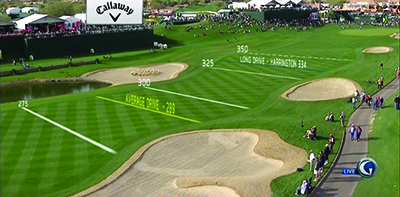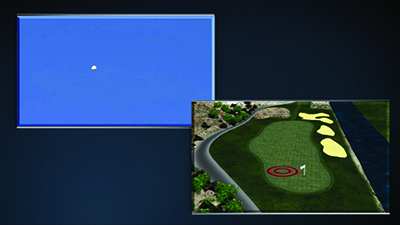Hitting a Virtual Hole in One

Virtual Driving Grid displays an onscreen graphic that shows yardage markers depicting the distance of a player’s tee shot. DURHAM, N.C.—For the PGA’s 98th season, which began in January, the Golf Channel and NBC launched a new look for their “2013 PGA TOUR” coverage based on three innovative virtual golf graphic technologies designed to enhance the viewing experience. These virtual graphics tools will be used on the 40 tournaments comprising this year’s tour, which culminates with the FedExCup Tour Championship in September.
The three technologies, PuttVision, 3D Landing Zone, and Virtual Driving Grid, were developed by SMT (SportsMEDIA Technology), a Durham, N.C. company that provides data integration, graphics presentation, and video enhancement solutions for live broadcast sports, news, and special events.
SMT’s golf technology is being used by the Golf Channel and NBC, as part of NBC Sports’ coverage of 2013 PGA TOUR events. “Our goal is to expand the audience for golf by providing technology that helps the casual observer better understand the sport while giving dedicated golf fans more reasons to watch and enjoy the game,” said Don Tupper, vice president of business development for SMT.
GOLF ILLUSTRATED
One of SMT’s best-known on-air products is the first down marker—the virtual yellow line that TV viewers see appear right on the football field—which has become indispensable during televised football games.
“This SMT technology has brought us closer to finding the yellow down line for golf,” said Scott Armstrong, director of tournament graphics and technology for the Golf Channel in Orlando, Fla. “The Golf Channel is always striving to present graphics that are not just eye candy for viewers but something that can educate and inform them,” Armstrong added. “By correlating data from previous shots or matches, SMT golf technologies can also help us to illustrate and tell compelling stories about the golfers’ performance and strategies in the game.”
SMT’s golf technology, based on its proprietary SMART (SportsMEDIA Augmented Reality Technology) platform, illustrates the challenges of making a putt; where a shot will land on the par-3 green; and the distance a tee shot traveled in relation to other drives, among other aspects of the game. By displaying graphical representations of the greens or fairway, viewers can see the putting line and distance the ball traveled from different aerial vantage points.
VIRTUAL DRIVING GRID
The Golf Channel and NBC first rolled out the “Virtual Driving Grid,” currently sponsored by Callaway, at the Hyundai Tournament of Champions on the Plantation Course in Kapalua, Hawaii in January.
Get the TV Tech Newsletter
The professional video industry's #1 source for news, trends and product and tech information. Sign up below.
Virtual Driving Grid displays an onscreen graphic that shows yardage markers depicting the distance of a player’s tee shot. This virtual graphic can also compare the length of different drives, such as the longest and shortest of the day.
“On-site calibration of the cameras and lenses can take two to three hours per camera. Once we have that calibration, we do test moves with the camera to allow us to draw the lines on the fairway at 250 yards, 300 yards, or wherever they need to be relative to the tee,” said Tupper. “When the ball is hit, the tracking data is automatically correlated so the landing is instantly marked by the line graphic. This technology is very similar to the first down line for football.”
3D LANDING ZONE
The 3D Landing Zone is a real-time graphic that predicts where a tee shot will land on a par-3 green. Within one second of the ball being struck, this technology analyzes the angle, speed, and direction of the ball in flight and predicts with remarkable accuracy where it will land. This virtual graphic technology was first used by the Golf Channel and NBC for events during the Waste Management Open in Phoenix in early February.
3D Landing Zone usually uses a splitscreen presentation grid, with one live video window showing the ball being shot while another video window shows a graphical representation predicting where it’s expected to land, using pulsing red circles to mark the site in relation to the hole. The 3D Landing Zone—a partnership between SMT and Trackman Golf—leverages Trackman technology, which uses Doppler radar to instantly analyze the trajectory and speed of the ball. Trackman’s system publishes a data stream to SMT’s graphical system to indicate where the predicted landing will be so it can be put on the display.
PUTTVISION
PuttVision displays the optimal putting path on a 3D model of the green. Since advertisers can sponsor these golf tools, the putting line is currently sponsored by Fidelity Investments during events carried by the Golf Channel or NBC. In any of the four-day tournaments that comprise the 2013 PGA TOUR, the Golf Channel airs Thursday/Friday rounds, while NBC or CBS airs Saturday/ Sunday rounds. Now that the Golf Channel and NBC are under the NBC Universal umbrella, they closely coordinate their 2013 PGA productions.

The 3D Landing Zone, a real-time graphic that predicts where a tee shot will land on a par-3 green usually uses a split screen with one live video window showing the ball being shot while another video window shows a graphical representation predicting where it’s expected to land, using pulsing red circles to mark the site in relation to the hole. “We can illustrate the challenges of a particular putt by drawing a virtual line between the ball and the hole to show the optimal line the ball will have to break due to contours and slopes on the greens,” Tupper said. “We can also show a virtual putt line after the golfer hits it, all in real time during live production. These tools give home viewers valuable insight into the challenges of the sport that are not readily apparent.”
The Golf Channel’s “Putt of the Month” segment, which is assembled in post-production, can take historical putting data captured during live shows and recreate putt lines to compare different golfers’ performances at past tournaments.
“The Golf Channel has amassed an impressive library of digital media assets, as well as data metrics, from televised golf events that can be harnessed during live or post-produced segments,” said Armstrong. “The PGA TOUR also has a tremendous amount of historical scoring and performance data that we can pull from and use to enrich our virtual golf displays to help tell stories and explain the game.”
In producing these live graphics, one of the biggest technical challenges is providing proper perspective to the viewer; for example, positioning cameras high enough to get an aerial perspective of the fairway. While most camera towers on golf courses are 12 to 20 feet high, these graphics require the camera to be positioned at a height of 40 to 60 feet. “Towers that high don’t exist at most golf courses and there’s no practical place to put them that won’t obstruct spectators’ views,” said Tupper. “Also, if we put scaffolds in place, our camera crews must get certified by onsite operations and insurance teams and wear safety harnesses before they climb up there to man the cameras.
“We’re currently investigating other means of achieving the same ends, such as putting cameras onto cranes, to make it easier to get these shots,” Tupper added.
As the company that also provides camera tracking for IndyCar racing league, SMT is used to working around precarious sites as well as pushing for better ways to achieve the desired live graphics effect.
“Since we launched these golf technologies over three months ago, I’ve spoken with someone from SMT on a daily basis, if not every other day, to review the way we’re executing these graphics and brainstorming ways to make them the best they can be,” Armstrong said. “I don’t think any other vendor could have developed and implemented these new technologies as quickly as they did. ”

